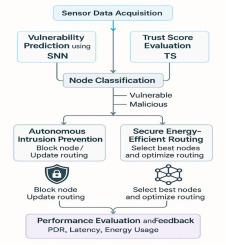Neuro inspired deep learning based secure and energy efficient routing with autonomous intrusion prevention in wireless sensor networks
IF 8
2区 计算机科学
Q1 AUTOMATION & CONTROL SYSTEMS
Engineering Applications of Artificial Intelligence
Pub Date : 2025-10-18
DOI:10.1016/j.engappai.2025.112783
引用次数: 0
Abstract
Wireless Sensor Networks (WSNs) are crucial in mission-driven domains such as environmental monitoring, industrial control, and military surveillance. However, their open communication medium, constrained resources, and unattended deployment make them prone to routing-layer attacks. Existing security frameworks mostly rely on reactive intrusion detection systems or conventional deep learning models, which incur high computational overhead and fail to adapt effectively under dynamic network conditions. To overcome these limitations, this study proposes a Neuro-Inspired Deep Learning Framework based on Spiking Neural Networks (SNNs) for autonomous intrusion prevention and energy-aware routing. The proposed model leverages latency-based spike encoding of key behavioral metrics (e.g., residual energy, latency, routing frequency, and packet delivery ratio) and utilizes a Leaky Integrate-and-Fire neuron architecture for proactive vulnerability prediction. Implementation using the Network Simulator-3 (NS-3) simulation tool and validation on the Wireless Sensor Network Dataset (WSN-DS), the framework achieves 99.72 % prediction accuracy, 99.98 % precision, 99.33 % recall, and 99.12 % F1-score, outperforming existing studies in attack detection rate. The proposed Secure Energy-Aware Routing Metric (SEARM) protocol achieves an average energy consumption of 0.32 J and a packet delivery ratio of 99.1 % while maintaining performance across varying network sizes (30–150 nodes) and attack intensities (up to 50 %). Additionally, the model features a self-healing mechanism that reintegrates previously blocked nodes based on dynamic trust recovery. This research establishes a proactive, low-power, and intelligent security paradigm for WSNs and sets the foundation for future innovations in biologically inspired and scalable network protection strategies.

无线传感器网络中基于神经启发的深度学习的安全节能路由与自主入侵防御
无线传感器网络(WSNs)在环境监测、工业控制和军事监视等任务驱动领域至关重要。然而,它们开放的通信媒介、受限的资源和无人值守的部署使它们容易受到路由层攻击。现有的安全框架大多依赖于响应式入侵检测系统或传统的深度学习模型,计算量大,不能有效适应动态网络环境。为了克服这些限制,本研究提出了一种基于峰值神经网络(snn)的神经启发深度学习框架,用于自主入侵防御和能量感知路由。提出的模型利用基于延迟的关键行为指标(例如,剩余能量,延迟,路由频率和数据包传送率)的尖峰编码,并利用泄漏集成和激活神经元架构进行主动漏洞预测。利用Network Simulator-3 (NS-3)仿真工具进行实现,并在无线传感器网络数据集(WSN-DS)上进行验证,该框架的预测准确率达到99.72%,精密度达到99.98%,召回率达到99.33%,f1得分达到99.12%,在攻击检测率方面优于现有研究。所提出的安全能量感知路由度量(SEARM)协议在不同网络规模(30-150个节点)和攻击强度(高达50%)下保持性能的同时,实现了0.32 J的平均能耗和99.1%的数据包传送率。此外,该模型还具有自我修复机制,该机制基于动态信任恢复重新集成先前阻塞的节点。该研究为wsn建立了一个主动、低功耗和智能的安全范例,并为未来生物启发和可扩展的网络保护策略创新奠定了基础。
本文章由计算机程序翻译,如有差异,请以英文原文为准。
求助全文
约1分钟内获得全文
求助全文
来源期刊

Engineering Applications of Artificial Intelligence
工程技术-工程:电子与电气
CiteScore
9.60
自引率
10.00%
发文量
505
审稿时长
68 days
期刊介绍:
Artificial Intelligence (AI) is pivotal in driving the fourth industrial revolution, witnessing remarkable advancements across various machine learning methodologies. AI techniques have become indispensable tools for practicing engineers, enabling them to tackle previously insurmountable challenges. Engineering Applications of Artificial Intelligence serves as a global platform for the swift dissemination of research elucidating the practical application of AI methods across all engineering disciplines. Submitted papers are expected to present novel aspects of AI utilized in real-world engineering applications, validated using publicly available datasets to ensure the replicability of research outcomes. Join us in exploring the transformative potential of AI in engineering.
 求助内容:
求助内容: 应助结果提醒方式:
应助结果提醒方式:


